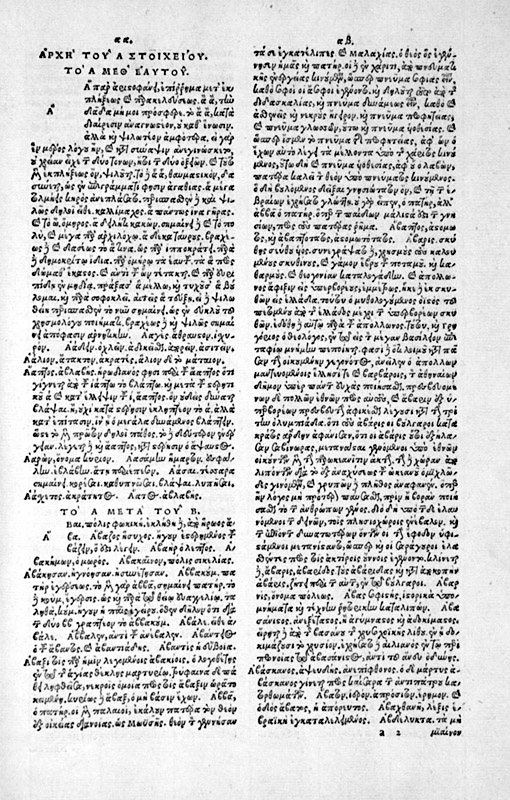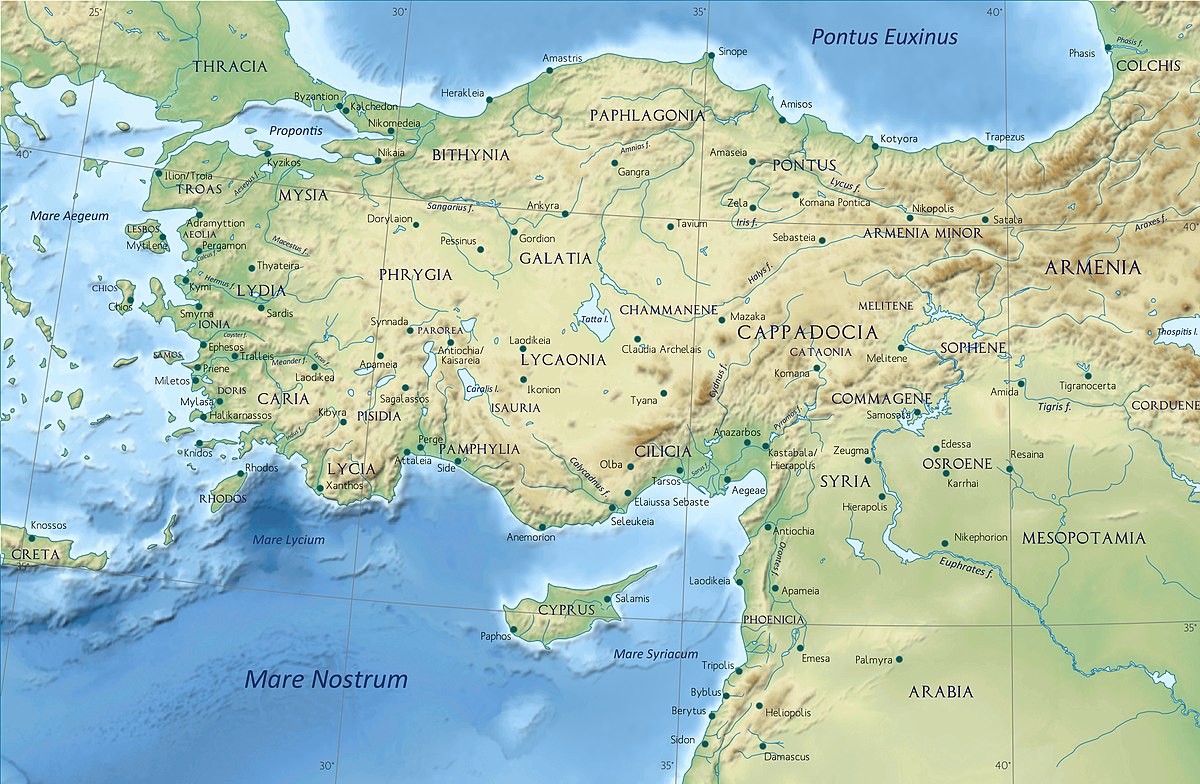URL:
THE SETTLEMENT OF THE MARDAITES AND THEIR MILITARY-ADMINISTRATIVE POSITION IN THE THEMATA OF THE WEST: A CHRONOLOGY
MILOŠ CVETKOVIĆ
Mardaite soldiers were a significant factor in Byzantine-Arab relations in the border areas in the east of the Empire during the 7th century. Centuries later - in the late ninth and first half of the tenth century - they represented an important part of the Roman naval forces in Asia Minor and the Balkans; sources mention them as sailors in the theme of Kivireot and in the western themes of the Peloponnese, Nicopolis and Kefalonia.
Their relocation from the eastern border is a consequence of the treaty of Emperor Justinian II with the Arabs; historians, however, did not provide an answer to the question of when colonization was carried out in the three mentioned topics in the west. It is unlikely that the Mardaites moved to the west at the end of the 7th century - when an agreement was made between Caliph Abimelech and Emperor Justinian II - because Constantinople did not have firm rule in the Peloponnese and Epirus at that time. It is hard to believe, then, that at that time, in parallel with the colonization of Mardait into the Kivireot theme, some of them were moved to the Balkans. The rule of Byzantium in the Peloponnese was established a whole century after the conclusion of the mentioned agreement, more precisely after Stavraki's campaign in 783. Therefore, the time of the settlement of the Mardait garrison in the southern Balkans should be sought in the interval between 783 and 877/878. year, when the Peloponnesian Mardaites first appear. Consequently, it can be concluded that the Mardait colonists came to the Balkans, not from Syria and Lebanon, but from Ataleia in the Kivireot theme, where they lived from the end of the 7th century, forming part of a special military-administrative unit headed by Katepan. Although there are no original data that explicitly speak about the colonization of Mardaites in the Peloponnese, some sources, such as the Monemvasia Chronicle, provide information on colonization measures that could be indirectly linked to the Mardaite migration.
The author of the mentioned chronicle talks about the immigration of, among others, Thracians, Armenians and certain Kafirs to the area of the Peloponnesian theme in the time of Emperor Nichifor I. Peter Charanis believes that the mysterious Kafirs were, in fact, inhabitants of the Kivireot theme, assuming that writing about these events, he had before him information about the settlers, whereby those from the subject of Kivireot in the template are listed in abbreviated form as Kiviri (Κιβυρρ / Κοιβαιρ), which the chronicler mistranslated as Kafiri. Bearing in mind that in the quoted section of the Monemvasia Chronicle, the infidels are listed on a par with the Thracians, who were inhabitants of the Thracian theme, as well as the Armenians, probably members of the Armenian theme, Haranis's interpretation seems to be correct. In that case, it is about the topic of Kivireot. Among the Kivireots who were relocated at that time, there could certainly have been Atalean Mardaites. Therefore, it can be assumed that it was Emperor Nichifor I who was responsible for the relocation of the Mardaites of Asia Minor to the Balkans. Their settlement could have aimed at strengthening Byzantine rule and overpowering the Slavic ethnic element, at a time when a new theme was being formed in the Peloponnese. The mentioned emperor, by the way, undertook extensive colonizing measures throughout the Empire. On the other hand, the settlement in the remaining two topics in the west - Nikopol and Kefalonia - was carried out somewhat later than in the Peloponnese, since the first mention of Nikopol and Kefalonian Mardaites is related to events in the first half of the 10th century. Their relocation was realized as part of the strengthening of the Byzantine positions in the Ionian Sea after the battles with the Arabs in that area around 880. The Mardaite migration in Epirus probably took place in parallel with the formation of the Nikopol theme, in order to strengthen its recruiting potential. Western-themed Mardaites functioned in units under the leadership of the Turmarch. In each of the three mentioned themes in the Balkans, there was one Mardaite prison, similar to the model of Persian ethnic prisons that were distributed in themes throughout the Empire during the 9th century. Similar to their military-administrative structure, other ethnic prisons stationed in various Roman themes functioned, such as the prisons of the Goths, Bulgarians or Evidits.
THE SETTLEMENT OF THE MARDAITES AND THEIR MILITARY-ADMINISTRATIVE POSITION IN THE THEMATA OF THE WEST: A CHRONOLOGY
MILOŠ CVETKOVIĆ
Mardaite soldiers were a significant factor in Byzantine-Arab relations in the border areas in the east of the Empire during the 7th century. Centuries later - in the late ninth and first half of the tenth century - they represented an important part of the Roman naval forces in Asia Minor and the Balkans; sources mention them as sailors in the theme of Kivireot and in the western themes of the Peloponnese, Nicopolis and Kefalonia.
Their relocation from the eastern border is a consequence of the treaty of Emperor Justinian II with the Arabs; historians, however, did not provide an answer to the question of when colonization was carried out in the three mentioned topics in the west. It is unlikely that the Mardaites moved to the west at the end of the 7th century - when an agreement was made between Caliph Abimelech and Emperor Justinian II - because Constantinople did not have firm rule in the Peloponnese and Epirus at that time. It is hard to believe, then, that at that time, in parallel with the colonization of Mardait into the Kivireot theme, some of them were moved to the Balkans. The rule of Byzantium in the Peloponnese was established a whole century after the conclusion of the mentioned agreement, more precisely after Stavraki's campaign in 783. Therefore, the time of the settlement of the Mardait garrison in the southern Balkans should be sought in the interval between 783 and 877/878. year, when the Peloponnesian Mardaites first appear. Consequently, it can be concluded that the Mardait colonists came to the Balkans, not from Syria and Lebanon, but from Ataleia in the Kivireot theme, where they lived from the end of the 7th century, forming part of a special military-administrative unit headed by Katepan. Although there are no original data that explicitly speak about the colonization of Mardaites in the Peloponnese, some sources, such as the Monemvasia Chronicle, provide information on colonization measures that could be indirectly linked to the Mardaite migration.
The author of the mentioned chronicle talks about the immigration of, among others, Thracians, Armenians and certain Kafirs to the area of the Peloponnesian theme in the time of Emperor Nichifor I. Peter Charanis believes that the mysterious Kafirs were, in fact, inhabitants of the Kivireot theme, assuming that writing about these events, he had before him information about the settlers, whereby those from the subject of Kivireot in the template are listed in abbreviated form as Kiviri (Κιβυρρ / Κοιβαιρ), which the chronicler mistranslated as Kafiri. Bearing in mind that in the quoted section of the Monemvasia Chronicle, the infidels are listed on a par with the Thracians, who were inhabitants of the Thracian theme, as well as the Armenians, probably members of the Armenian theme, Haranis's interpretation seems to be correct. In that case, it is about the topic of Kivireot. Among the Kivireots who were relocated at that time, there could certainly have been Atalean Mardaites. Therefore, it can be assumed that it was Emperor Nichifor I who was responsible for the relocation of the Mardaites of Asia Minor to the Balkans. Their settlement could have aimed at strengthening Byzantine rule and overpowering the Slavic ethnic element, at a time when a new theme was being formed in the Peloponnese. The mentioned emperor, by the way, undertook extensive colonizing measures throughout the Empire. On the other hand, the settlement in the remaining two topics in the west - Nikopol and Kefalonia - was carried out somewhat later than in the Peloponnese, since the first mention of Nikopol and Kefalonian Mardaites is related to events in the first half of the 10th century. Their relocation was realized as part of the strengthening of the Byzantine positions in the Ionian Sea after the battles with the Arabs in that area around 880. The Mardaite migration in Epirus probably took place in parallel with the formation of the Nikopol theme, in order to strengthen its recruiting potential. Western-themed Mardaites functioned in units under the leadership of the Turmarch. In each of the three mentioned themes in the Balkans, there was one Mardaite prison, similar to the model of Persian ethnic prisons that were distributed in themes throughout the Empire during the 9th century. Similar to their military-administrative structure, other ethnic prisons stationed in various Roman themes functioned, such as the prisons of the Goths, Bulgarians or Evidits.



















Comment